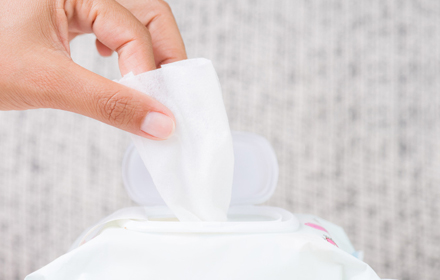Summary: A wet wipes is a type of disposable...
A
wet wipes is a type of disposable wipe that is used for cleaning and personal hygiene. It comes in different forms such as folded, individually wrapped, or in dispensers. Dispensers contain several wipes, while a single roll contains a large number. Wet wipes are widely used in household cleaning and personal hygiene, but differ from medical wipes, which contain chemicals that are not meant for skin hygiene.Nonwoven fabric for wet wipes is a fabric that is used in the manufacturing of wipes. This fabric is designed to hold the chemical solution in place. It is manufactured using an embossed process. A nonwoven fabric can be either made from a single layer or made in multiple layers.Its name comes from a Chinese character. It is also called Cong Lai nouetsutowaipusu.
Wet wipes
Selected high-quality cellulose fiber as raw material, processed by special technology. After water and essence, the material is comfortable and soft, and it cares for delicate skin. Wipe does not produce relative slip and cleans skin more effectively.
In addition to Ben Fa Ming, other names for this fabric include Ben Ming Xi Shu, Bu Zhi Bu nioite, Fang Xiang suru, and Suo Ding niokeru.Polyester is the most commonly used fiber in wet wipes, accounting for nearly 65% of the total consumption of non-woven fiber in this sector. However, the composition of these products varies widely, with different types of wipes made of 100% polyester or a blend of polyester and other fibers.Polyester is a great material for wet wipes. Its high strength and hydrophilic absorption make it a good material choice. Wet wipes are often made from 100% polyester spunlace, which lowers the manufacturing cost for manufacturers.Wet wipes are a great way to clean your hands without sanitizing the sink.
However, they can be dangerous if they are made of materials that aren't recyclable. Aluminum, for example, has the potential to be harmful to the environment and is not a sustainable option. In addition, this material is not biodegradable, meaning that it cannot be recycled.Wet wipes are also contributing to the waste generated by the distribution process. Many companies have begun to look for alternative transportation options. For example, some well-known wet wipes companies are considering using LNG instead of diesel. LNG is a cleaner fuel than diesel and produces fewer greenhouse gases. Trucks that run on LNG also reduce noise pollution and carbon dioxide emissions.The material for wet wipes is a blend of viscose fibres and chemical pulp fibres. The fibres are manufactured in an industrial scale line at Kelheim Fibres. The fibres in the blend have a linear mass density of 2.4 dtex.
The fibres in the blend have varying degrees of absorbency.This material is not recyclable. It is either thrown away or burned for energy. This means it will stay in the environment for years to come, affecting animals and plants. This is especially problematic when wet wipes are packaged in sachets, which encourage their use in places where waste is not collected.Spinninglace wet wipes material can offer high tensile strength and softness. However, spinlace wipes are not biodegradable and can clog the sewage system. As a result, this material is not suitable for flushing. In order to produce flushable wet wipes, the fiber length must be less than 20 millimeters.
